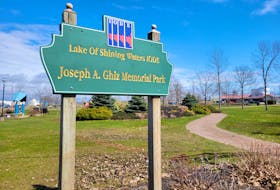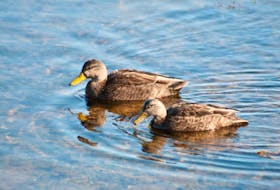People could be fishing, canoeing or kayaking and walking the trails at Wright’s Creek/Andrew’s Pond on the eastern end of Charlottetown within the next 12-24 months.
The Wright’s Creek Watershed Environmental Committee is currently having the main pond dredged and efforts will be ongoing through Oct. 14. Work can be seen taking place heading towards the neighbourhood of East Royalty on Route 2, just past the KFC outlet.
It’s one of the final stages of returning the watershed to its original glory. The siltation from the airport and surrounding residential developments has been minimized, new springs have been opened up and rock-lined to prevent it from happening again.
The latest effort has been to dredge the creek and pond to its original depth. It used to be 12 to 14 feet deep but, due to siltation, was reduced to about six feet and, in some cases, as little as two feet.
“We keep being surprised as to how much silt there is,’’ said John Andrew, co-chair of the watershed committee.
“You think there might be only four to five feet (of silt) and you find eight feet. We’re hitting old tree stumps and fallen trees (but) anything we find that’s waterlogged we dig out and put back in. It’s good for fish habitat.’’
“When I come in each day I’m just amazed at how much bigger the pond is,’’ said Coun. Terry Bernard, who represents residents in the area. “We’re dragging the old silt out and taking it back to its original (depth). You can now see how much wider (Andrew’s Pond) is.’’
The city corporation is spending $60,000 on the restoration project with the watershed group chipping in an additional $18,000. On top of that, the wildlife conservation fund is helping out with about $4,000 for developing things like a new trail system while the provincial government contributes more than $9,000 annually to help with projects such as this one.
The watercourse, and in particular Andrew’s Pond, suffered major damage caused by storm water runoff from the expanding airport, filling the only large body of fresh water within the city’s boundaries. In the 1950s, provincial wildlife officials routinely claimed that more fish were caught in Andrew’s Pond on the first day of the fishing season than in any other pond in P.E.I.
“We’re trying to create as much habitat as we can for what we’re doing,’’ said Darren Riggs, co-chair of the watershed committee. “It’s going to be a totally different spot when it’s all done and the water is back in.’’
The scope of what the committee has been able to accomplish over the past seven years is dramatic when a tour of the area follows pictures of what the area used to look like.
“We’re already noticing a rebound in the trout stock,’’ Riggs said. “The fish will move in if you give them a home. We’re breathing new life into the habitat.’’
And, they’re breathing new life into what was one of the busier watering spots in the province decades ago.
“This will be an urban setting the kids can come down to,’’ Riggs said.
People could be fishing, canoeing or kayaking and walking the trails at Wright’s Creek/Andrew’s Pond on the eastern end of Charlottetown within the next 12-24 months.
The Wright’s Creek Watershed Environmental Committee is currently having the main pond dredged and efforts will be ongoing through Oct. 14. Work can be seen taking place heading towards the neighbourhood of East Royalty on Route 2, just past the KFC outlet.
It’s one of the final stages of returning the watershed to its original glory. The siltation from the airport and surrounding residential developments has been minimized, new springs have been opened up and rock-lined to prevent it from happening again.
The latest effort has been to dredge the creek and pond to its original depth. It used to be 12 to 14 feet deep but, due to siltation, was reduced to about six feet and, in some cases, as little as two feet.
“We keep being surprised as to how much silt there is,’’ said John Andrew, co-chair of the watershed committee.
“You think there might be only four to five feet (of silt) and you find eight feet. We’re hitting old tree stumps and fallen trees (but) anything we find that’s waterlogged we dig out and put back in. It’s good for fish habitat.’’
“When I come in each day I’m just amazed at how much bigger the pond is,’’ said Coun. Terry Bernard, who represents residents in the area. “We’re dragging the old silt out and taking it back to its original (depth). You can now see how much wider (Andrew’s Pond) is.’’
The city corporation is spending $60,000 on the restoration project with the watershed group chipping in an additional $18,000. On top of that, the wildlife conservation fund is helping out with about $4,000 for developing things like a new trail system while the provincial government contributes more than $9,000 annually to help with projects such as this one.
The watercourse, and in particular Andrew’s Pond, suffered major damage caused by storm water runoff from the expanding airport, filling the only large body of fresh water within the city’s boundaries. In the 1950s, provincial wildlife officials routinely claimed that more fish were caught in Andrew’s Pond on the first day of the fishing season than in any other pond in P.E.I.
“We’re trying to create as much habitat as we can for what we’re doing,’’ said Darren Riggs, co-chair of the watershed committee. “It’s going to be a totally different spot when it’s all done and the water is back in.’’
The scope of what the committee has been able to accomplish over the past seven years is dramatic when a tour of the area follows pictures of what the area used to look like.
“We’re already noticing a rebound in the trout stock,’’ Riggs said. “The fish will move in if you give them a home. We’re breathing new life into the habitat.’’
And, they’re breathing new life into what was one of the busier watering spots in the province decades ago.
“This will be an urban setting the kids can come down to,’’ Riggs said.
Following are some of the notable accomplishments by the Wright’s Creek Watershed Environmental Committee since 2006.
• Construction of a spawning pool for smelts and salt water trout below Andrew’s Dam, summer 2006.
• Construction of a silt trap to catch sediment entering Andrew’s Pond from Sherwood, summer 2007.
• Construction of a sediment trap to catch sediment entering Andrew’s Pond from the upper section of Wright’s Creek, summer 2008.
• Construction of 1,700 feet of trail along Andrew’s Pond, spring 2008.
• Restoration of three spring areas near the headwaters of Andrew’s Pond. An excavator was used to dig out the springs and to line the edges with Island sandstone, summer 2009.
• An excavator was used to deepen and widen the trout access route to the star-shaped spring. There are now hundreds of small trout in the spring.
• An additional spring was dug out along the west side of the former Barbour’s Pond.
• A large 100-foot long trap was constructed in a marshy area in the headwaters of Andrew’s Pond with the goal of not only collecting silt but providing a pool of deeper water in the area for fish habitat. The trap is about 12 to 20 feet wide. Water in the trap is at the same level as in Andrew’s Pond and is about six feet deep.
• The small channel that was in the former pond bed was deepened and widened slightly to provide better fish habitat. An in-stream silt trap was formed. Two choked-up springs were opened up and deepened and their outlets connected to the main stream in such a way that the springs were in a backwater.
• Fallen trees and debris has been removed from the pond.
• They created a holding pond/silt trap to reduce siltation arising from the Island Coastal pit near the beginning of Wright’s Creek.
• The watershed group has planted 850 trees along the watershed.








